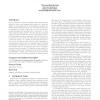Free Online Productivity Tools
i2Speak
i2Symbol
i2OCR
iTex2Img
iWeb2Print
iWeb2Shot
i2Type
iPdf2Split
iPdf2Merge
i2Bopomofo
i2Arabic
i2Style
i2Image
i2PDF
iLatex2Rtf
Sci2ools
IPSN
2007
Springer
2007
Springer
The worst-case capacity of wireless sensor networks
The key application scenario of wireless sensor networks is data gathering: sensor nodes transmit data, possibly in a multi-hop fashion, to an information sink. The performance of sensor networks is thus characterized by the rate at which information can be aggregated to the sink. In this paper, we derive the first scaling laws describing the achievable rate in worst-case, i.e. arbitrarily deployed, sensor networks. We show that in the physical model of wireless communication and for a large number of practically important functions, a sustainable rate of Ω(1/ log2 n) can be achieved in every network, even when nodes are positioned in a worst-case manner. In contrast, we show that the best possible rate in the protocol model is Θ(1/n), which establishes an exponential gap between these two standard models of wireless communication. Furthermore, our worst-case capacity result almost matches the rate of Θ(1/ log n) that can be achieved in randomly deployed networks. The high rate i...
| Added | 08 Jun 2010 |
| Updated | 08 Jun 2010 |
| Type | Conference |
| Year | 2007 |
| Where | IPSN |
| Authors | Thomas Moscibroda |
Comments (0)

